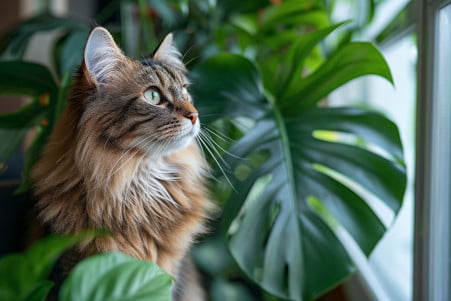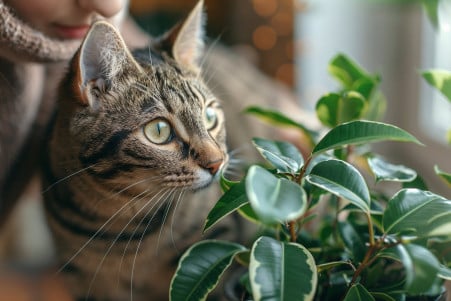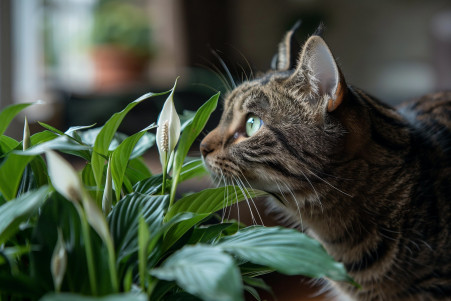Do Fiddle Leaf Figs Hurt Cats? What Pet Owners Should Know
19 April 2024 • Updated 19 April 2024

Many cat parents are drawn to the beauty of fiddle leaf figs, but they may worry about their cats' interest in these exotic plants. Fiddle leaf figs are only mildly toxic to cats. However, the insoluble calcium oxalates in the leaves and stems can lead to oral irritation, excessive drooling, vomiting, and difficulty swallowing in cats that eat the plant.
As concerned pet parents, we will look at veterinary toxicology research to learn more about the dangers of fiddle leaf figs to cats. We will also discuss how to safely have fiddle leaf figs in a home with cats, including how to limit a cat's exposure to the plant and how to tell if a cat has been poisoned. With this information, you can make choices that help you enjoy your plants while keeping your cat safe.
Are fiddle leaf figs toxic to cats?
Fiddle Leaf Fig Toxicity: What Are the Risks?
Fiddle leaf figs contain insoluble calcium oxalate crystals, which are the toxic principle for cats, according to the ASPCA's overview. These sharp, needle-like crystals can cause irritation and damage to a cat's mouth, throat, stomach, and skin if ingested or touched, as explained in this veterinary guide.
Symptoms of fiddle leaf fig poisoning in cats can include drooling, swelling of the mouth and lips, vomiting, appetite loss, and in severe cases, breathing difficulties or blood pressure issues, according to fiddle leaf fig experts. While classified as only mildly toxic (Toxicity Class 4), ingestion of large amounts can potentially lead to more severe illness, as noted by Catster's analysis.
The level of toxicity varies depending on the amount ingested and the individual cat's size, age, and overall health. Smaller amounts may only cause mild irritation, while larger ingestions pose a higher risk of gastrointestinal issues and potential airway obstructions. Pet parents should be aware of these risks so they can decide whether or not to keep fiddle leaf figs in their homes if they have cats.
How to Avoid Fiddle Leaf Fig Poisoning in Cats
The most effective way to avoid fiddle leaf fig poisoning in cats is to keep the plants in a location that cats can't access, according to the Kitsap Humane Society. Pet-friendly repellents or bitter-tasting sprays can be applied to the plants to discourage cats from chewing on or playing with them, according to PlantologyUSA.
Redirecting cats' attention by offering them other forms of enrichment and providing them with safe, non-toxic plants to interact with, such as cat grass or catnip, can also help keep cats away from fiddle leaf figs, Greg pointed out. In addition, cat owners can keep fiddle leaf figs in cat-free areas or rooms to create a cat-friendly environment, according to FloraSource.
It's also important to monitor cats around fiddle leaf figs and remove any plant material they consume as soon as possible, according to the experts. By doing so, cat owners can enjoy these attractive plants in their homes without putting their pets at risk.
What to Do if Your Cat Eats a Fiddle Leaf Fig
If you think your cat has eaten part of a fiddle leaf fig, don’t delay in getting in touch with a vet and act quickly to remove the plant from your cat’s mouth and isolate your cat to prevent further exposure, the Dwarf Fiddle Leaf Fig experts say. Make sure to tell the vet about the exposure, including the type of plant and the amount your cat may have eaten.
Treatment may include inducing vomiting, giving activated charcoal to absorb the toxins, and providing supportive care, the Fig Poisoning in Cats guide explains. In more serious cases, your cat may need to be hospitalized for observation and to treat any complications. Don’t try to treat your cat at home, as this can make things worse.
It’s important to get your cat to the vet as soon as possible, the Homes and Gardens experts say. With quick treatment and proper care, the impact of fiddle leaf fig poisoning can often be reduced. By knowing the signs and symptoms and acting quickly, cat owners can help keep their pets safe.
Safe Houseplant Alternatives
For cat owners who are also plant lovers, there are plenty of non-toxic, pet-friendly houseplants to choose from, notes the team at Bond Vet. Options that are safe for cats include cat grass, catnip, African violets, palms, air plants, ferns, orchids, and succulents. These plants can add beauty and air-purifying qualities to your home without the danger of poisoning your pet.
Lively Root's pet-friendly plant collection includes showy flowering plants, such as the Christmas cactus, and trendy air purifiers like the Money Tree. While many plants are safe for both cats and dogs, some plants that are non-toxic to dogs can cause stomach upset in cats, and vice versa. The best way to keep pets from eating your houseplants is to keep them out of reach or use cat grass to keep cats occupied.
Architectural Digest lists 22 pet-friendly plants that are safe for cats and dogs, including the Chinese Money Plant, Hoya species, Rattlesnake Plant, and a variety of succulents. No matter what plants you choose, always make sure to check their toxicity and consult with experts or reputable sources before bringing them home, recommends Prevention. Offering safe, interactive plants can help cats feel more at home and meet their natural needs.
Conclusion: How to Balance Houseplants and Cats
Fiddle leaf figs are lovely plants to have in your home, but their mild toxicity to cats means that you need to be careful when bringing them into a home with cats. However, by knowing the risks and taking steps to mitigate them, you can safely have fiddle leaf figs in your home. This includes making sure to get your cat to the vet as soon as possible if they do eat any part of the plant.
With the right knowledge and care, you can have the best of both worlds—plants in your home and a healthy cat. This may mean looking for plants that are safe for cats or finding ways to keep your cats away from your plants.


